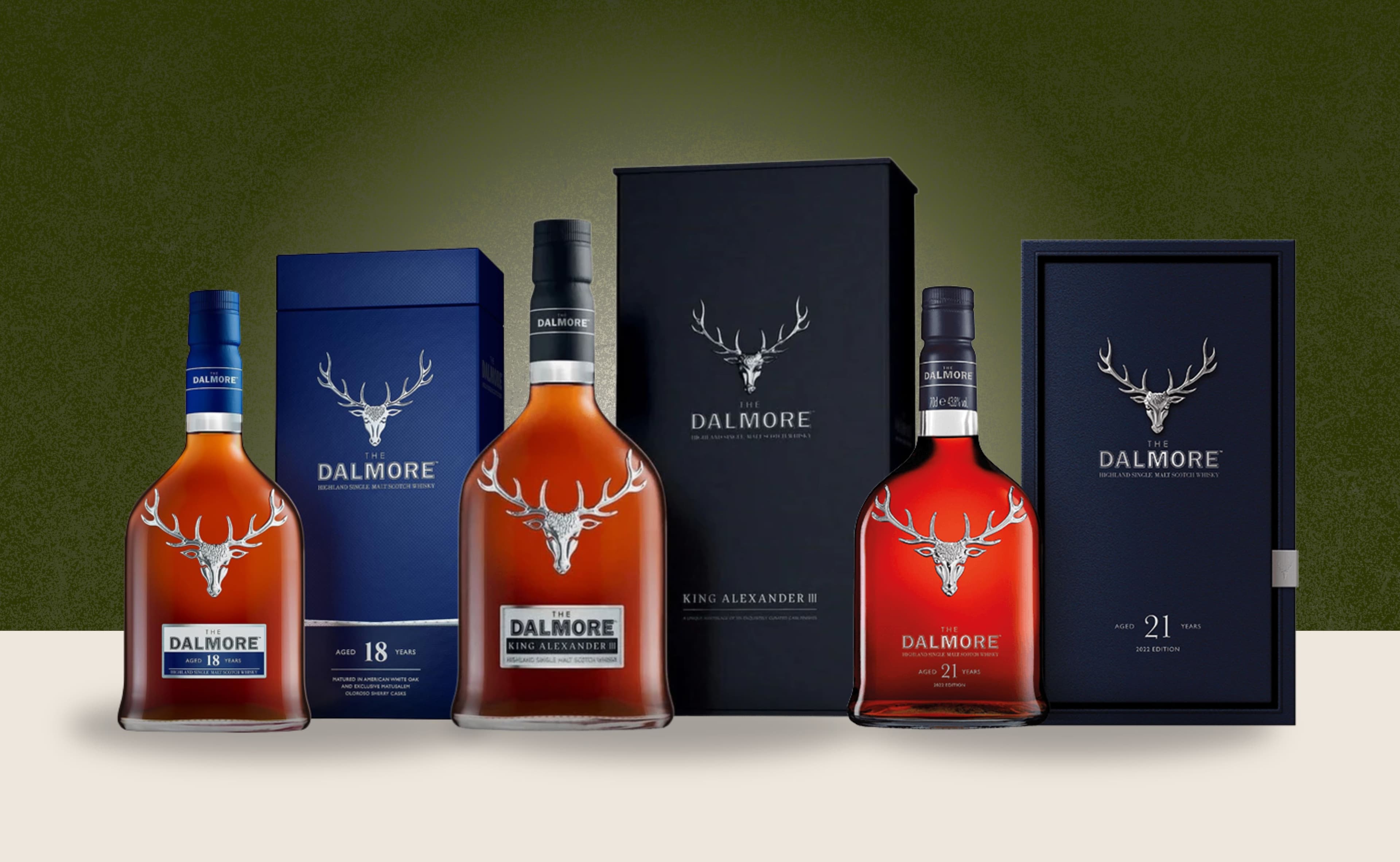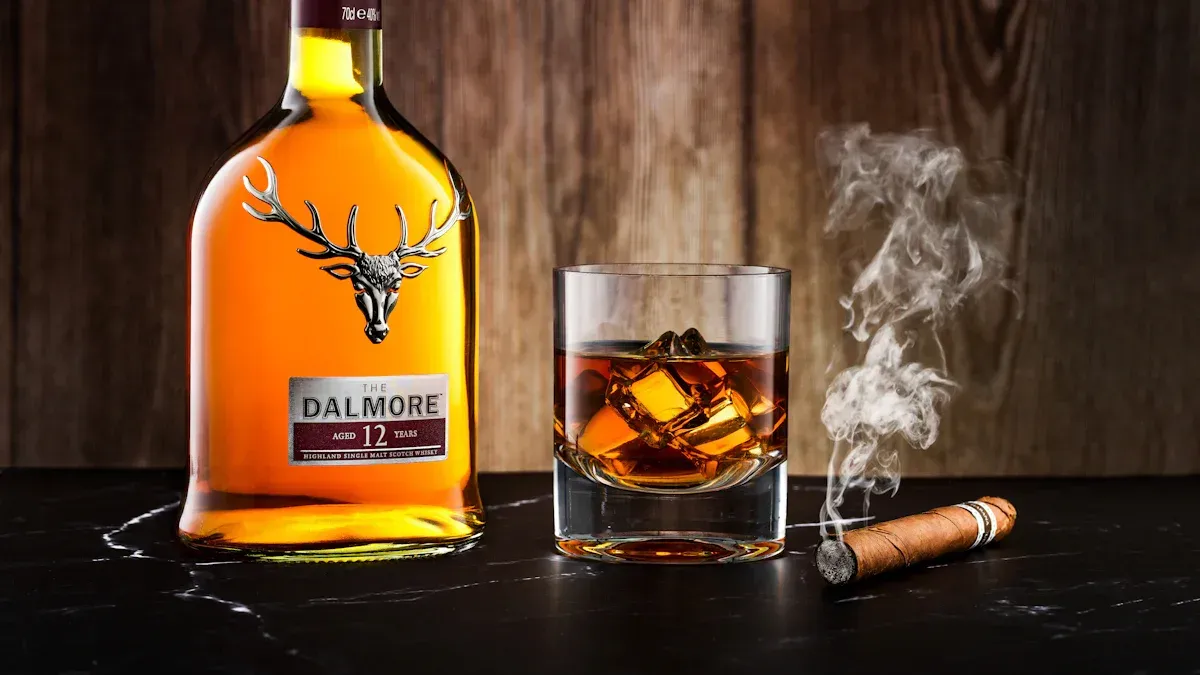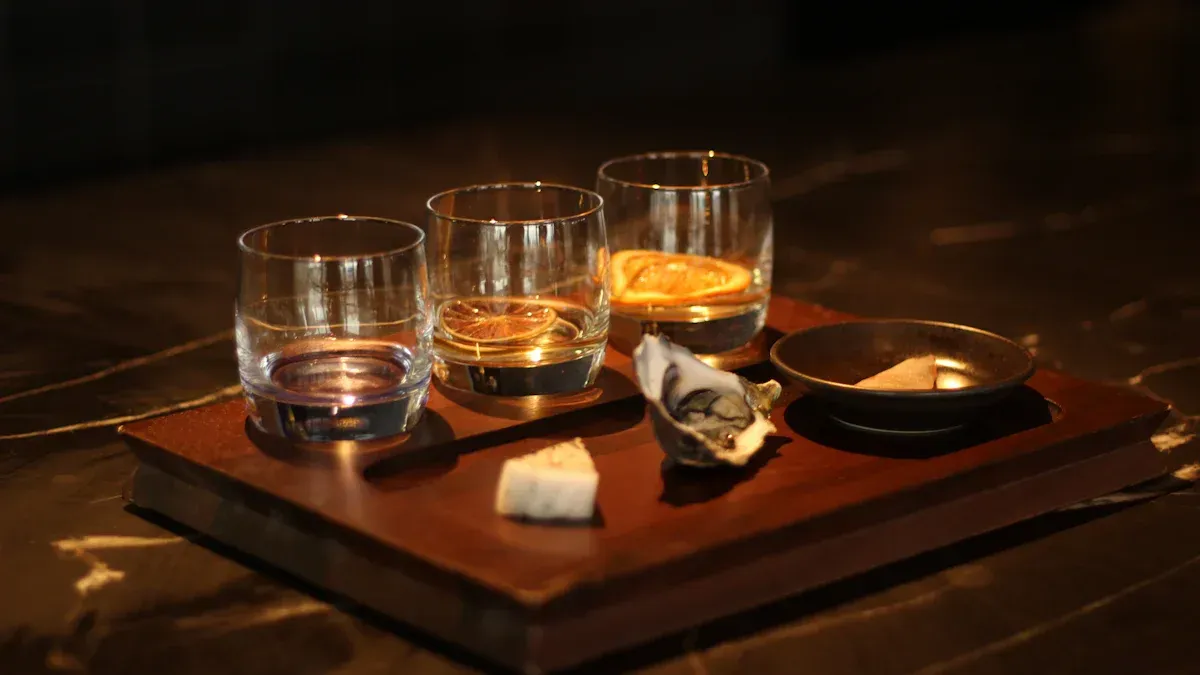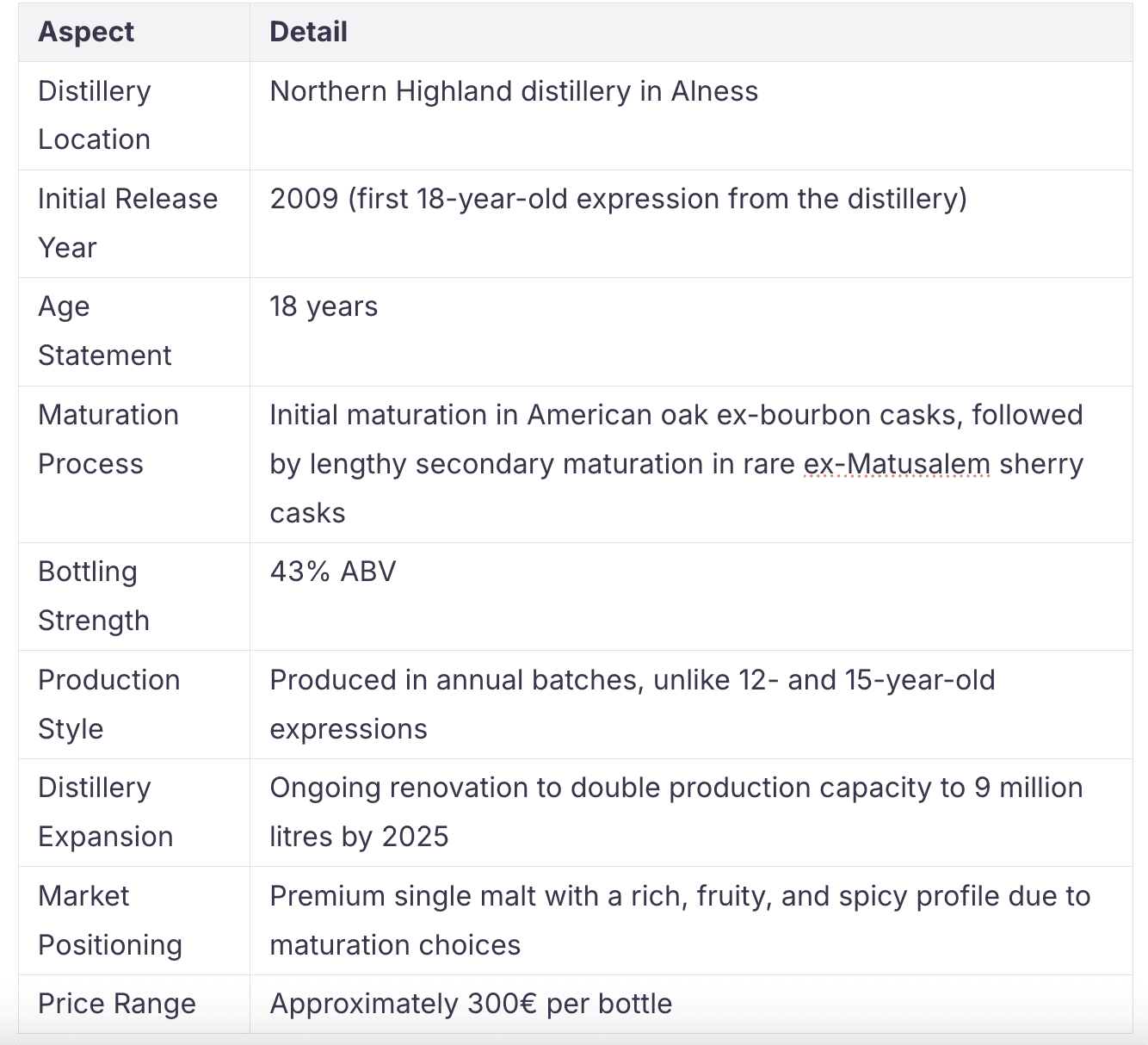07.07.2025
The evolution of Dalmore whisky and 3 must-try Dalmore Scotch bottles in 2025

The evolution of Dalmore whisky and 3 must-try Dalmore Scotch bottles in 2025
Dalmore stands as a symbol of luxury and innovation in Scotch whisky. In 2025, three bottles demand attention: King Alexander III, Dalmore 18 Years Old, and Dalmore 21 Years Old. Each showcases exceptional craftsmanship and mastery in cask maturation. The royal stag emblem on every bottle reflects a legacy rooted in history and prestige. These expressions capture the essence of what makes Dalmore unique.
Key Takeaways
-
Dalmore single malts blend a rich history with modern innovation, starting from 1839 and continuing through family legacies and new technology.
-
The distillery uses a special multi-cask maturation process with rare sherry, port, and wine casks to create deep, complex flavors.
-
Dalmore’s signature taste features notes of orange marmalade, dark chocolate, and roasted coffee, offering a smooth and elegant drinking experience.
-
Three standout Dalmore bottles in 2025—King Alexander III, 18 Years Old, and 21 Years Old—showcase unique aging methods and rich flavor profiles.
-
Dalmore bottles hold strong appeal for collectors due to their rarity, prestige, and limited releases that often increase in value.
Dalmore History

Origins and Founding
-
The Dalmore distillery began in 1839, established by Alexander Matheson. He built his fortune through Jardine, Matheson & Co., a trading company that rose after the East India Company's monopoly ended.
-
In 1867, Matheson transferred the leasing rights to the Mackenzie brothers. They introduced the iconic 12-point stag emblem and started exporting whisky beyond Scotland.
-
By 1870, Dalmore became the first malt whisky brand to reach international markets, using its coastal location to ship products to Australia and New Zealand.
-
The distillery faced interruptions during both World Wars. The site was repurposed for military use and suffered significant damage.
-
In 1960, after nearly a century under family ownership, Dalmore merged with Whyte & Mackay, which expanded the single malt range.
The Mackenzie Legacy
The Mackenzie family’s connection to Dalmore traces back through genealogical records. The 'History Of The Mackenzies' by Alexander Mackenzie documents that Thomas Mackenzie, a descendant of Kenneth Og, established the Mackenzie lineage in Braemar. This direct family link highlights the Mackenzies’ foundational role in shaping Dalmore’s heritage. The brothers not only introduced the stag emblem but also set new standards for quality and maturation, ensuring the distillery’s reputation for excellence.
Modern Era and Innovation
-
Digital marketing and social media now play a vital role in reaching new generations of whisky enthusiasts.
-
Dalmore provides transparency about sourcing and environmental impact, aligning with consumer values.
-
The distillery uses hybrid pot stills with reflux control, blending tradition with modern technology.
-
Sustainable practices, such as water conservation and responsible sourcing, have become standard.
-
Virtual tastings, influencer collaborations, and immersive storytelling enhance brand loyalty.
-
Blockchain and augmented reality offer interactive experiences and traceability, appealing to tech-savvy consumers.
Dalmore’s journey reflects an unbroken chain of whisky makers, from the Mackenzie family to Richard Paterson and now Gregg Glass. Each generation has preserved tradition while embracing innovation, ensuring the distillery’s continued leadership in the world of Scotch whisky.
Dalmore Distinctiveness
Cask Maturation
Dalmore stands out in the world of fine scotch whisky for its innovative approach to cask maturation. The distillery pioneered the use of multiple cask types, a method that brings depth and complexity to each expression. Master whisky makers select American white oak ex-bourbon barrels for the initial aging. These casks impart notes of vanilla and honey. After this stage, the whisky moves to hand-selected casks from renowned sherry bodegas and wine estates in Spain and Portugal. These partnerships allow access to rare Matusalem, Apostoles, and Amoroso sherry casks, as well as vintage port pipes. Each cask adds unique flavors and aromas, creating a layered profile that few distilleries can match.
Note: Dalmore single malts relationship with historic bodegas and wineries have lasted for generations. This commitment ensures a consistent supply of exceptional casks, which is essential for producing world-class whisky.
Signature Flavor
Dalmore’s signature flavor profile sets it apart from other single malts. The whisky often displays rich notes of orange marmalade, dark chocolate, and roasted coffee. Hints of spice, dried fruits, and nuts appear in every sip. The influence of sherry and port casks brings a luxurious mouthfeel and lingering finish. Each bottle offers a balance between sweetness and spice, with a smooth texture that appeals to both new and experienced whisky drinkers. The complexity and elegance of Dalmore’s flavor come from careful cask selection and patient aging, making every dram a memorable experience.
Dalmore Bottles 2025

Dalmore King Alexander III
Dalmore King Alexander III stands as a tribute to the distillery’s royal heritage. This expression honors the legendary act of bravery by Colin of Kintail, who saved King Alexander III from a charging stag in 1263. The whisky showcases a pioneering approach to cask maturation. The master whisky makers use six different types of casks: American white oak, Matusalem oloroso sherry, Madeira, Marsala, port, and Cabernet Sauvignon wine casks. Each cask adds a distinct layer of flavor.
King Alexander III offers a complex nose with hints of red berries, citrus zest, and chocolate. The palate reveals notes of stewed fruits, creamy vanilla, and roasted coffee. The finish lingers with gentle spice and a touch of oak. This bottle appeals to collectors and enthusiasts who appreciate innovation and history in a single malt. The multi-cask process creates a whisky that balances richness, depth, and elegance.
Tip: King Alexander III makes an excellent gift for those who value both tradition and creativity in Scotch whisky.
Dalmore 18 Years Old
Dalmore 18 Years Old represents the distillery’s commitment to patience and precision. This expression matures first in American oak ex-bourbon casks, then spends a lengthy secondary period in rare Matusalem sherry casks from Spain. The result is a whisky with remarkable depth and character.

Dalmore 18 Years Old greets the nose with aromas of orange marmalade, dark chocolate, and spice. The palate delivers layers of dried fruits, nuts, and a hint of espresso. The finish is long, warming, and slightly sweet. Annual batch production ensures consistency and exclusivity. This bottle suits those who seek a refined, full-bodied Scotch with a story behind every sip.
Dalmore 21 Years Old
Dalmore 21 Years Old showcases the pinnacle of the distillery’s aging expertise. The whisky spends over two decades maturing in American oak before finishing in rare 30-year-old Matusalem oloroso sherry casks. This extended maturation imparts a luxurious texture and a symphony of flavors.
On the nose, Dalmore 21 year presents notes of toffee, figs, and roasted nuts. The palate unfolds with layers of dark chocolate, ripe plums, and gentle spice. The finish is exceptionally smooth, with lingering hints of sherry and oak. This expression appeals to connoisseurs who appreciate complexity and rarity in their whisky.
Note: The Dalmore Luminary Series releases, including special editions of the 21 Years Old, have become highly sought after. These limited luxury releases highlight the artistry of the master whisky makers and offer collectors a rare opportunity to own a piece of Dalmore history.
Each of these fine scotch whisky bottles—King Alexander III, 18 Years Old, and 21 Years Old—captures the essence of Dalmore’s legacy. They combine tradition, innovation, and exceptional flavor, making them essential choices for 2025.
Dalmore’s story blends deep heritage with modern innovation.
-
Founded in 1839, the distillery uses historic equipment and advanced cask maturation.
-
Over 50 years of partnership with González Byass ensures quality sherry casks.
-
Only about 5% of production is bottled as single malt, highlighting exclusivity.
-
Record-breaking auction prices and collectible releases show global prestige.
The King Alexander III, 18 Years Old, and 21 Years Old bottles stand out in 2025 for their rarity, expert acclaim, and unique maturation. Enthusiasts seeking more can explore the broader range for new discoveries.
FAQ
What makes Dalmore whisky unique?
Dalmore whisky stands out for its multi-cask maturation process. Master whisky makers use rare sherry, port, and wine casks. This approach creates rich, complex flavors that set Dalmore apart from other single malts.
How should someone enjoy Dalmore whisky?
Experts recommend serving Dalmore neat in a tulip-shaped glass. This glass helps concentrate the aromas. Adding a few drops of water can open up the flavors for a deeper tasting experience.
Are Dalmore bottles good for collectors?
Collectors value Dalmore bottles for their rarity and prestige. Limited releases, such as the Luminary Series, often appreciate in value. Dalmore’s reputation for quality makes these bottles highly sought after.
What is the significance of the stag emblem?

The stag emblem honors Colin of Kintail’s legendary act of saving King Alexander III. It represents Dalmore’s royal connection and commitment to excellence.
About the author

Max Rink
I'm a whisky enthusiast and a writer in the making. I enjoy exploring new flavors, learning about the history behind each bottle, and sharing what I discover along the way. This blog is my space to grow, connect, and raise a glass with others who love whisky as much as I do.
To the author